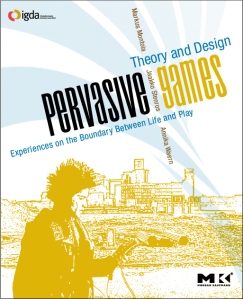During the writing of the book we have been trying to put together a history of pervasive games. Though the term is only a few years old, games that fit our description (such as treasure hunts, puzzle quests and killers) have been played for a much longer time. Fairly early we realized that it would not be possible to present this history as a chronology. It would simply be too large a task to try to explain the evolutions of everything from letterboxing to scavenger hunts and orienteering. In the end we would have ended up looking at the history of abstract ludic structures such as hunts and puzzles.
But more importantly, history is not straightforward, but a collection of separate traditions that have sprung up and vanished only to inspire others through example, stories told and misunderstandings. It is almost impossible to map the influences of a game designer. For example, should all global races be counted as being inspired by Jules Verne if they were staged after Le tour du monde en quatre-vingts jours came out? Indeed, it seems that fiction about games has been even more influential than other games in the emergence of new gaming traditions. Much more people have seen the film Running Man or read the novels of Philip K. Dick than have participated in most pervasive games.
Due to the scattered and muddled nature of the history of these games, it is always exciting when a clear chain of events can be uncovered. (Putting history in a clear and easy-to-understand sequence gives a sense of control and understanding over it — and though that sense is ultimately false, it is damn satisfying.) Usually the histories that can be written are the stories of individual gaming traditions, but sometimes those traditions are connected. Recently Scott from Puzzalot commented on my posting on The Last of Sheila: He has been tracing the steps from the Belfiore tradition of games to Midnight Madness to the Luskin tradition to the The Last of Sheila to the Sondheim and Perkins games. He speculates, just as we do in the book, that these games were probably influenced by Elsa Maxwell’s hunts, but he can’t find any proof to back this up either.
Maxwell, famously, claims to have invented treasure and scavenger hunts. Though she did a lot to popularize them, they did exist as folk games before that (for example there is letterboxing that dates back to mid 19th century, the history of orienteering in the Nordic countries goes back to late 19th century and I suspect that the Polish podchody has a fairly long history as well).
Scott speculated what inspired Maxwell. He points towards Cecil Adams’ take on the history of burying treasure:
Though it’s not where the premise first appeared, Robert Louis Stevenson’s Treasure Island was instrumental in planting the treasure map concept in the popular consciousness.
I feel a little stupid for never thinking about Treasure Island since it contains not only the treasure but also the race, the hunt. And since it did first come out in early 188o’s, it would be quite nicely timed for planting the idea in the collective imagination. I really need to refresh my memory on adventure fiction.
And speaking of late 19th century adventure fiction, I seem to recall that there is a passage in a book by Mark Twain that describes role-playing or pretend play somewhere. If anyone recalls such a passage, please point me towards the right place.



One of the most interesting treasure hunts I came across when researching for the books was Oak Island; an authentic island outside Canada where people have been digging for a treasure since the nineteenth century. There actually seems to have been something hidden there once; but whether there is anything there still nobody knows (and academics doubt). The hunt is still on though, and grows increasingly playful year by year http://www.oakislandtreasure.co.uk/
By: Waern on July 16, 2009
at 07:46
[…] for Good). The ones I’m particularly happy made the top ten are my additional notes on the history of treasure hunts and our course […]
By: Year in Review « Pervasive Games: Theory and Design on June 7, 2010
at 11:45
Hello! This is all very interesting to me: thanks for writing it up: very helpful and interesting. I’m trying to track down the history of a number of puzzles for a big project of mine, one manifestation of which is an upcoming course on puzzles I’m about to teach at Rutgers University.
The novel that is now called _Treasure Island_ first appeared in serialized form in 1881-82, and was published in book form in 1883.
But Poe’s short story, ‘The Gold-Bug’, was published in 1843. ‘The Gold-Bug’ inspired Stevenson’s writing of _Treasure Island_, as Stevenson himself admitted.
Moreover, ‘The Gold-Bug’ has the hero following a set of careful directions to the buried treasure. The directions first have to be deciphered (a process which Poe covers in depth), and then they need to be carefully interpreted to lead the reader to the treasure.
I don’t yet know of any such stories from before ‘The Gold-Bug’.
Thank you again!
By: Justin Kalef on December 14, 2021
at 16:32